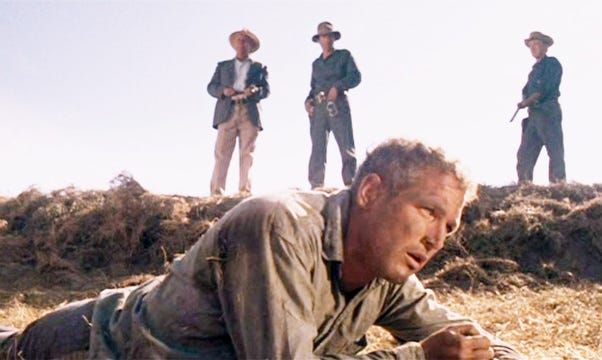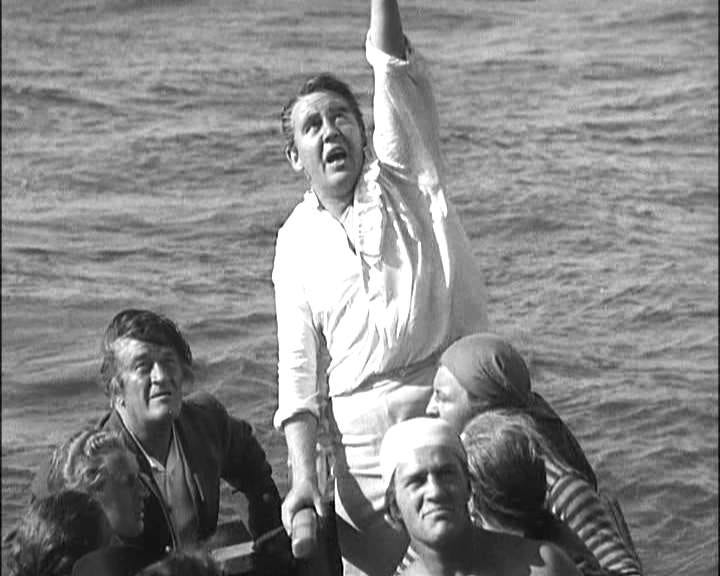Talk to Each Other
A new survey shows intergenerational communication is the worst it's ever been.
When I have a difficult conversation on my to-do list, or have a key moment in a project where I have to work with someone I dislike, I tend to put it off as long as possible until I absolutely have to do it. This is not healthy and actually - counterintuitively! - prolongs the discomfort that the task is bringing me by making me continue to think about it after the timeframe I could have just sucked it up and gotten it done.
Now take that attitude of avoidance and apply it across the entire office and segment it by generation. That’s the situation that nearly half of companies find themselves in: 40% of older Gen Xers and baby boomers have not directly spoken to a Gen Zer. On the flip side of that, 20% of Gen Zers haven’t spoken face-to-face to someone over 50. It’s enough to make Strother Martin want to murder someone.
Then Why Are We Back In the Office?
If a large part of the forced return to office was about personal communication and speaking directly to each other, why are 40% of those who decision-makers (under the assumption that most leaders in today’s corporate world skew older) simply not talking to their younger colleagues? All of the talk about facilitating conversation and in-person productivity and the cringeworthy creative combustion - and then when we finally return, the Xers and Boomers want to play a game of telephone with middle management.
If communication reverted to the open office mean of increased instant messaging and email, why are we suffering the commute to come in? These collaboration tools that people turned to when open office plans were unfurled enabled us to not only get through Covid productively, but can also give added flexibility to junior employees. This is a worthy salve to alleviate the burn of the cold shoulder leadership seems to be giving.
Avoid the Mutiny
In one of the greatest films of all time, a mustache-less Clark Gable must manage an overtly dictatorial and cruel captain in about the HMS Bounty while trying to maintain peace between him and the midshipmen running the day-to-day swashbuckling operations. Charles Laughton’s Captain Bligh would put forth his diktats for the crew and hole up in the captain’s quarters - a veritable suite compared to the midshipman’s bunks.
Communication usually went through Gable’s Christian Fletcher, who tended to side with his men (solid middle management for productive teams), but Bligh’s stubborn persistence to his nonsensical rules and his isolation from most of the rank and file led to his downfall, and he quickly finds himself adrift in the open ocean in a lifeboat.
Now it’s doubtful that direct communication between Bligh and the crew would have prevented the mutiny - his management style could best be described as insufferable brutality. But he likely would have caught wind of the mutiny before it was successfully pulled off had that communication line been open.
Earn Goodwill
But Bligh’s problem wasn’t only communication - his hard-nosed tactics were universally derided by his crew. But more direct conversations could have helped him understand his crew’s misgivings.
Face-to-face communication tends to cut much of the negatives from written comms away: when we see facial expressions, body language, and hear tone we are much less likely to misinterpret the speaker’s intent. We are much more likely to reach agreement on a difficult topic in person, and it allows for dual empathy for stronger bonds and relationships.
There’s a reason agencies spend a lot of time and money flying pitch teams out to various locations to win business and not simply send the deck with an email to prospects. Let’s apply more of that to internal communications and team building.
Break Generational Habits
“These kids just don’t get it” is a perma-phrase heard around offices since the beginning of the white collar work force. Older generations denigrating the younger ones about how inane and naïve they are is a right of passage into middle age and beyond. Every generation in leadership has had misgivings about incoming entry-levels based on cultural clashes.
But it’s not the TikTok-ing or the return to 90s normcore in their clothes or the utterances of “Skibidi toilet” around the office that has the olds concerned. It’s what it represents: change.
Change terrifies management - so much so they are willing to throw money at the problem, contributing to a $1 trillion (with a T) management consulting industry, made up of recent college grads Googling the shit out of a company’s problem and translating the findings into Powerpoint. All of the hard work putting in processes and optimizing workflows is at risk when change comes knocking, and those kids with the hanging cross earrings are ushering it in. Fast.
So what you see from managers when this happens is a doubling down on old norms to combat this unique form of ephebiphobia. Commute to the office, work 9-5, endure rush hour both ways - because that’s how it’s always been done. It’s their version of “clinging to guns and religion” as the world that they know changes in front of their eyes.
And while that’s a perfectly natural human response, it leads to discord between the old way of doing things and the new world order. Good leaders will lean into the new - figuring out what makes the new generation tick, and begin to tailor recruiting, onboarding, and office process and culture around it. They are fully aware that this is the future, regardless of if they want it or not.
Poor leaders will buck against it, institute inflexible work policies, and try to maintain the status quo as much as possible to remain comfortable. But that’s a losing formula in a world in which change has accelerated so rapidly it’s hard to spot the harbingers of it before it’s arrival. Those who try to keep things the same in a world changing around them will become not only out of touch, but even worse: irrelevant.
So leaders - get out there and roam the halls of your hallowed offices. Shake hands, kiss babies. Get to know your newest employees because these are the folks who, in a few short decades, will be in the cockpit (and likely suffering the same fears you have for today’s youth.) And newbies: listen to your leaders - especially if they’re making an effort to connect - because they may certainly lack the rizz, but they have been around the block a few times and have plenty to pass on to a younger generation willing to listen and learn. See, I get it.
Grab Bag Sections
WTF Chiefs: We all remember how triggered certain people got that Taylor Swift had the audacity to show up to NFL games to root on her golden retriever of a boyfriend who happened to play tight tend for the franchise. The Chiefs and the NFL intelligently capitalized on newfound interest from women and played up the Swiftie element, gaining many female fans for the franchise and sport in the process.
And now the Chiefs are doing everything to ruin it all. Three-time Superbowl winning kicker Harrison Butker recently told a group of graduating seniors from Benedictine College that - and this newsletter is paraphrasing here - women should remain barefoot, pregnant, and subservient to their husbands and gays represent a fatal flaw in humanity.
Now, we could talk about how Butker’s mother is a successful medical physicist, or how the Catholic Church still has decades of reckoning to do over its global pedophilia scandal, but the real story here is the reaction to Butker’s speech. You might think it’s been universal backlash, but following the money the reality is that Butker’s jersey sales have taken off. “Gays are awful” and “Female productivity begins and ends in the kitchen” may not play well in the mainstream news, but we need to remember that the NFL is a league outraged over peaceful protest during the National Anthem and led by owners whose views on race would make George Wallace proud.
Swifties may have given the NFL a shot in the arm when it came to new fans of the female persuasion. But they’re going to begin following a league that, when boiled down to its very basics, is just grown men smashing into each other over and over until they need to retire from injuries and slowly lose their minds from well-documented (and even better dismissed) medical conditions like CTE. So welcome to the league, Swifties. It may also be best not to ask what Chief’s Assistant coach Britt Reid (and Andy Reid’s son) did before you buy that Travis Kelce jersey.
Album of the Week: If you took all of the downers in the Bay Area in 1969 and molded them into an album, what you would get is Crosby, Stills & Nash. Despite their apparent dislike for the Oxford comma, the supergroup knew how to jam.
While we take for granted how revolutionary the album was today, it helped usher in an era of blues and folk foundations in rock. That Geffen-curated Cali sound emanates throughout, with “Suite: Judy Blue Eyes” and “Wooden Ships” absolute classics. “Marrakesh Express” - an upbeat record in which you can almost smell the Rif Mountain hashish wafting out of Nash’s clothes - is an objectively bad song, but was one of two Top 40 hits stemming from the album (the other being “JBE.”)
The vocal mash up on “Helplessly Hopeful” can’t help but make you root for the protagonists (and I love a good numbers-based pun.) “Guinnevere” and “Lady of the Island” seem to make time stand still. “Long Time Gone” and “49 Bye Byes” are a great one-two punch to end the album on an energetic high note.
Quote of the Week: “If you have an important point to make, don't try to be subtle or clever. Use a pile driver. Hit the point once. Then come back and hit it again. Then hit it a third time - a tremendous whack.” - Winston Churchill
See you next week!









